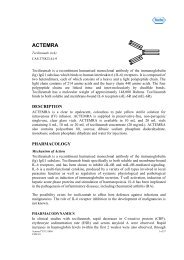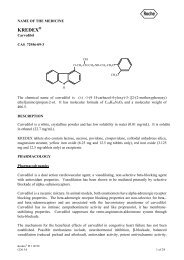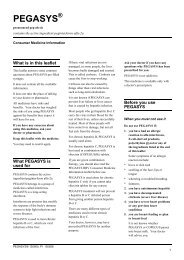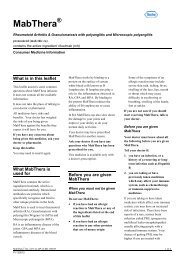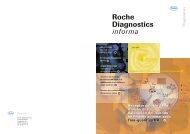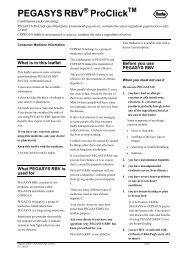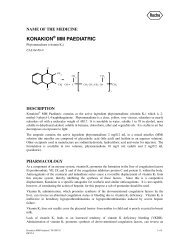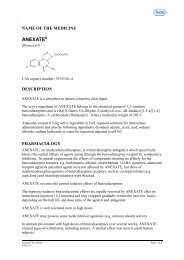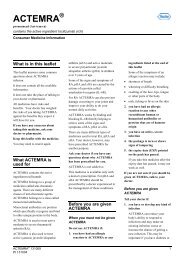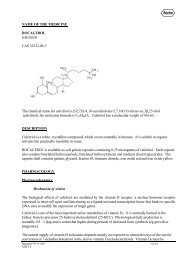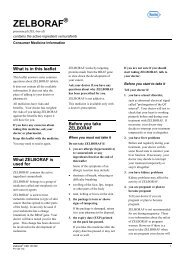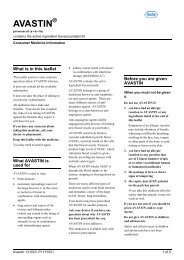Product Information PI - Roche Australia
Product Information PI - Roche Australia
Product Information PI - Roche Australia
You also want an ePaper? Increase the reach of your titles
YUMPU automatically turns print PDFs into web optimized ePapers that Google loves.
NAME OF THE MEDICINE<br />
<br />
TAMIFLU 6 mg/mL powder for oral suspension and<br />
capsules<br />
oseltamivir phosphate<br />
CAS registry number: 204255-11-8<br />
O<br />
O<br />
HN<br />
COOC 2<br />
H 5<br />
NH .<br />
2<br />
H 3<br />
PO 4<br />
The chemical name (3R,4R,5S)-4-acetylamino-5-amino-3-(1-ethylpropoxy)-1-cyclohexene-1-<br />
carboxylic acid, ethyl ester, phosphate (1:1). The chemical formula is C 16 H 28 N 2 O 4 (free<br />
base). The molecular weight is 312.4 for oseltamivir free base and 410.4 for oseltamivir<br />
phosphate salt.<br />
DESCRIPTION<br />
Oseltamivir phosphate is a white crystalline solid, highly soluble in water (> 500 mg/mL).<br />
TAMIFLU (oseltamivir phosphate) is available as hard capsules for oral use. Each 75 mg<br />
hard capsule of TAMIFLU contains 98.5 mg oseltamivir phosphate, equivalent to 75 mg of<br />
oseltamivir. Each 45 mg hard capsule of TAMIFLU contains 59.1 mg oseltamivir phosphate,<br />
equivalent to 45 mg of oseltamivir. Each 30 mg hard capsule of TAMIFLU contains 39.4 mg<br />
of oseltamivir phosphate, equivalent to 30 mg of oseltamivir.<br />
The hard capsules contain the following excipients: starch – pregelatinised maize, talc,<br />
povidone K 30, croscarmellose sodium and sodium stearylfumarate. The capsule shell<br />
contains gelatin, titanium dioxide, iron oxide red CI77491, iron oxide yellow CI77492, iron<br />
oxide black CI77499, shellac and indigo carmine CI73015.<br />
TAMIFLU is also available as powder for oral suspension. Each bottle, with 13 g powder for<br />
oral suspension, contains 0.5122 g of oseltamivir phosphate and when constituted with 55 mL<br />
water results in a concentration of 6 mg/mL of oseltamivir. Each bottle contains the<br />
following excipients: xanthan gum, sodium dihydrogen citrate, sodium benzoate, sorbitol,<br />
saccharin sodium, titanium dioxide and Tutti-Frutti flavouring.<br />
Tamiflu <strong>PI</strong> 6 mg/mL oral suspension and capsules 120119 1 of 28<br />
CDS 10.0
PHARMACOLOGY<br />
Pharmacodynamics<br />
Mechanism of Action<br />
Oseltamivir phosphate is a pro-drug of the active metabolite, oseltamivir carboxylate. The<br />
active metabolite is a selective inhibitor of influenza virus neuraminidase enzymes, which are<br />
glycoproteins found on the virion surface. Viral neuraminidase is essential for the release of<br />
recently formed virus particles from infected cells and the further spread of infectious virus in<br />
the body. A study in cultured tracheobronchial epithelial cells and primary nasal epithelial<br />
cells has shown that oseltamivir may also suppress virus entry to cells.<br />
In Vitro Susceptibility Tests<br />
Antiviral susceptibility and development of resistance to oseltamivir is usually discussed in<br />
the context of cell culture experiments involving Madin-Darby Canine Kidney (MDCK) virus<br />
reduction assay and/or neuraminidase inhibition assay (NA IC 50 ). The concentrations of<br />
oseltamivir carboxylate required for inhibition of influenza virus were highly variable<br />
depending on the assay method used and the virus tested. Oseltamivir carboxylate showed<br />
antiviral activity in the low nano-molar range in all these cell assays.<br />
In vitro neuraminidase enzyme IC 50 (NA IC 50 ) values for oseltamivir-susceptible clinical<br />
isolates of influenza A ranged from 0.1 – 1.3 nM and for influenza B from 2.6 – 8.7 nM.<br />
Reduced susceptibility to oseltamivir carboxylate has been recovered in vitro by passage of<br />
virus in the presence of increasing concentrations of oseltamivir carboxylate. In vitro NA<br />
IC 50 assays showed that the degree of reduced sensitivity (IC 50 ) differs markedly for different<br />
mutations from 2-fold for resistant variant with the I222V mutation in influenza A N1 to<br />
30 000-fold for resistant variant with the R292K mutation in influenza A N2.<br />
The relationship between the in vitro antiviral activity in cell culture and the inhibition of<br />
influenza virus replication in humans has not been established.<br />
Viral Resistance<br />
Reduced sensitivity of viral neuraminidase<br />
Clinical studies: The risk of emergence of influenza viruses with reduced susceptibility or<br />
resistance to oseltamivir has been examined in clinical studies (see Table 1). All patients who<br />
were found to carry oseltamivir-resistant virus did so transiently, cleared the virus normally<br />
and showed no worsening of the underlying symptoms.<br />
Table 1:<br />
Emergence of Influenza Viruses with Reduced Susceptibility or Resistance to<br />
Oseltamivir in Clinical Studies<br />
Patients with Resistance Mutations (%)<br />
Patient Population<br />
Phenotyping*<br />
Genotyping and Phenotyping*<br />
Tamiflu <strong>PI</strong> 6 mg/mL oral suspension and capsules 120119 2 of 28<br />
CDS 10.0
Adults and Adolescents 4/1245 (0.32%) 5/1245 (0.4%)<br />
Children (1 – 12 years) 19/464 (4.1%) 25/464 (5.4%)<br />
* Full genotyping was not performed in all studies.<br />
In clinical studies conducted in post-exposure (7 days), post-exposure within household<br />
groups (10 days) and seasonal (42 days) prophylaxis of influenza in immunocompetent<br />
persons, there was no evidence for emergence of drug resistance associated with the use of<br />
TAMIFLU. There was no resistance observed during a 12-week seasonal prophylaxis study<br />
in immunocompromised subjects.<br />
Clinical and surveillance data: Natural mutations associated with reduced susceptibility to<br />
oseltamivir in vitro have been detected in influenza A and B viruses isolated from patients<br />
without exposure to oseltamivir. For example, in 2008 the oseltamivir resistance-associated<br />
substitution H275Y was found in > 99 % of circulating 2008 H1N1 influenza isolates in<br />
Europe, while the 2009 H1N1 influenza (“swine flu”) was almost uniformly susceptible to<br />
oseltamivir. Resistant strains have also been isolated from both immunocompetent and<br />
immunocompromised patients treated with oseltamivir. The susceptibility to oseltamivir and<br />
the prevalence of such viruses appears to vary seasonally and geographically. Oseltamivir<br />
resistance has also been reported in patients with pandemic H1N1 influenza in connection<br />
with both therapeutic and prophylactic regimens.<br />
The rate of emergence of resistance may be higher in the youngest age groups, and in<br />
immunocompromised patients. Oseltamivir-resistant viruses isolated from oseltamivir-treated<br />
patients and oseltamivir-resistant laboratory strains of influenza viruses have been found to<br />
contain mutations in N1 and N2 neuraminidases. Resistance mutations tend to be viral subtype<br />
specific.<br />
Prescribers should consider available information on influenza virus drug susceptibility<br />
patterns for each season when deciding whether to use TAMIFLU (for the latest information,<br />
please refer to WHO and/or local government websites).<br />
Cross-Resistance<br />
Cross-resistance between zanamivir-resistant influenza mutants and oseltamivir-resistant<br />
influenza mutants has been observed in vitro. Due to limitations in the assays available to<br />
detect drug-induced shifts in virus susceptibility, an estimate of the incidence of oseltamivirresistance<br />
and possible cross-resistance to zanamivir in clinical isolates cannot be made.<br />
However, two of the three oseltamivir-induced mutations (E119V, H274Y and R292K) in the<br />
viral neuraminidase from clinical isolates occur at the same amino acid residues as two of the<br />
three mutations (E119G/A/D, R152K and R292K) observed in zanamivir-resistant virus.<br />
Pharmacokinetics<br />
Absorption<br />
Oseltamivir is absorbed from the gastrointestinal tract after oral administration of oseltamivir<br />
phosphate and is converted predominantly by hepatic esterases to the active metabolite. In<br />
multiple dose studies the peak concentration of the active metabolite occurs 2 – 3 hours after<br />
Tamiflu <strong>PI</strong> 6 mg/mL oral suspension and capsules 120119 3 of 28<br />
CDS 10.0
dosing. Following an oral dose of 75 mg twice daily, the peak concentration (C max ) of the<br />
active metabolite is approximately 350 – 400 ng/mL. At least 75% of an oral dose reaches<br />
the systemic circulation as the active metabolite. Exposure to the pro-drug is less than 5%<br />
relative to the active metabolite. Plasma concentrations of the active metabolite are<br />
unaffected by co-administration with food (see DOSAGE AND ADMINISTRATION).<br />
Distribution<br />
The active metabolite reaches all key sites of influenza infection as shown by studies in the<br />
ferret, rat and rabbit. In these studies, anti-viral concentrations of the active metabolite were<br />
seen in the lung, bronchoalveolar lavage, nasal mucosa, middle ear and trachea, following oral<br />
administration of oseltamivir phosphate.<br />
The mean volume of distribution (V ss ) of the active metabolite is approximately 23 L in<br />
humans. The binding of the active metabolite to human plasma protein is negligible<br />
(approximately 3%).<br />
Metabolism<br />
Oseltamivir is extensively converted to the active metabolite by esterases located<br />
predominantly in the liver. Neither oseltamivir nor the active metabolite is a substrate for, or<br />
an inhibitor of, the major cytochrome P450 isoforms. Thus, interactions mediated by<br />
competition for these enzymes are unlikely.<br />
Elimination<br />
Absorbed oseltamivir is primarily (> 90%) eliminated by conversion to the active metabolite.<br />
Peak plasma concentrations of the active metabolite decline with a half-life of 6 – 10 hours in<br />
most subjects. The active metabolite is not further metabolised and is eliminated entirely<br />
(> 99%) by renal excretion. Renal clearance (18.8 L/h) exceeds glomerular filtration rate (7.5<br />
L/h) indicating that tubular secretion (via the anionic pathway) in addition to glomerular<br />
filtration occurs. Less than 20% of an oral radiolabelled dose is eliminated in faeces.<br />
Special Populations<br />
Renal impairment<br />
Administration of 100 mg of TAMIFLU twice daily, for 5 days, to patients with various<br />
degrees of renal impairment showed that exposure to the active metabolite is inversely<br />
proportional to renal function.<br />
A population pharmacokinetic model describing the impact of creatinine clearance (CrCL) on<br />
oseltamivir and oseltamivir carboxylate pharmacokinetics was developed and qualified for<br />
simulation using 80 subjects with varying degrees of renal function. Subjects had dense<br />
pharmacokinetic profiles and were identified from three clinical studies; a study in subjects<br />
with either normal renal function or mild, moderate or severe renal impairment (WP15648)<br />
and two studies in healthy subjects receiving a range of single (WP15517) or multiple doses<br />
of oseltamivir (WP15525). Simulations were performed and suitable regimens using<br />
Tamiflu <strong>PI</strong> 6 mg/mL oral suspension and capsules 120119 4 of 28<br />
CDS 10.0
available capsule formulations were selected on the basis to provide oseltamivir carboxylate<br />
exposures considered safe and efficacious in clinical trials.<br />
Refer to DOSAGE AND ADMINISTRATION for recommended dosing for patients with<br />
severe, moderate and mild renal impairment.<br />
Two clinical studies were performed to evaluate the pharmacokinetic, safety and tolerability<br />
of oseltamivir and oseltamivir carboxylate in end stage renal disease patients undergoing<br />
haemodialysis (HD) and continuous ambulatory peritoneal dialysis (CAPD). In study<br />
PP15974 patients undergoing either CAPD or HD received a single 75 mg capsule of<br />
oseltamivir, whereas in study NP16472 patients received 30 mg oseltamivir oral suspension<br />
for 6.5 weeks, with CAPD patients receiving a single dose per week and HD patients a dose<br />
after alternate dialysis sessions. In order to assist in determining appropriate dosing<br />
recommendations in HD, a population pharmacokinetic model for HD was constructed and<br />
qualified for simulation. Suitable regimens using available capsule formulations were<br />
selected on their basis to achieve oseltamivir carboxylate plasma trough levels in subjects<br />
with normal renal function dosed at 75 mg twice daily for treatment, or 75 mg oseltamivir<br />
given orally once daily for prophylaxis.<br />
Refer to DOSAGE AND ADMINISTRATION for recommended dosing for patients with end<br />
stage renal disease undergoing haemodialysis and continuous ambulatory peritoneal dialysis.<br />
Hepatic impairment<br />
Based on in vitro and animal studies, significant increases in exposure to oseltamivir or its<br />
metabolite are not expected and this has been confirmed in clinical studies in patients with<br />
mild or moderate hepatic impairment. The pharmacokinetics of a single oral dose of<br />
oseltamivir 75 mg have been established in moderately hepatic impaired (Child-Pugh score 7<br />
– 9) patients. Results of the study showed that C max and AUC of active metabolite of<br />
oseltamivir in the 12 hepatic impaired patients fell within the therapeutic margin of safety and<br />
efficacy. The safety and pharmacokinetics in patients with severe hepatic impairment have<br />
not been studied (see DOSAGE AND ADMINISTRATION).<br />
Elderly<br />
Exposure to the active metabolite at steady-state was approximately 25% higher in elderly<br />
patients (age range 65 – 78 years old) compared to young adults given comparable doses of<br />
TAMIFLU. Half-lives observed in elderly patients were similar to those seen in young adults.<br />
On the basis of drug exposure and tolerability, dosage adjustments are not required for elderly<br />
patients for either treatment or prophylaxis of influenza unless there is co-existent renal<br />
impairment (see PRECAUTIONS and DOSAGE AND ADMINISTRATION).<br />
Paediatrics ≥ 1 year of age<br />
The pharmacokinetics of TAMIFLU have been evaluated in pharmacokinetic studies in<br />
children aged 1 – 16 years old. Multiple dose pharmacokinetics were studied in a small<br />
number of children aged 3 – 12 years old enrolled in a clinical trial. The rate of clearance of<br />
the active metabolite, corrected for bodyweight, was faster in younger children, than in adults,<br />
resulting in lower exposure in these children for a given mg/kg dose. Doses of 2 mg/kg and<br />
Tamiflu <strong>PI</strong> 6 mg/mL oral suspension and capsules 120119 5 of 28<br />
CDS 10.0
unit doses of 30 and 45 mg, administered to children in the appropriate categories according<br />
to the recommendation in the DOSAGE AND ADMINISTRATION section yield oseltamivir<br />
carboxylate exposures comparable to those achieved in adults receiving a single 75 mg<br />
capsule dose (approximately 1 mg/kg). With advancing age, the difference in exposure<br />
between children and adults (per mg/kg dose) lessened to the extent that the exposure in<br />
children over 12 years of age was similar to that in adults (see PRECAUTIONS and<br />
DOSAGE AND ADMINISTRATION).<br />
TAMIFLU should not be used in children under 1 year of age (see PRECAUTIONS -<br />
Toxicology).<br />
CLINICAL TRIALS<br />
Treatment of Influenza in Adults<br />
A total of 1355 patients were included in two phase III multicentre, placebo-controlled trials<br />
in naturally acquired influenza which were conducted in the Northern Hemisphere influenza<br />
season of 1997 – 1998 (Studies WV15670 & WV15671). An identical trial (Study<br />
WV15730) followed in the Southern Hemisphere winter of 1998 where 60 patients were<br />
recruited. The population used in the primary analyses was the intent-to-treat infected (ITTI)<br />
population. This population included only subjects who received at least one dose of study<br />
treatment and had laboratory-confirmed influenza. The intent-to-treat (ITT) population<br />
included all subjects who took at least one dose of study medication, regardless of whether<br />
they proved to have influenza. The results for the two pivotal studies are shown in Tables 2<br />
and 3.<br />
Table 2:<br />
Median Time (hours) to Alleviation of All Symptoms in the ITTI and ITT<br />
Populations<br />
Study<br />
Placebo<br />
(95% CI)<br />
WV15671 ITTI<br />
n = 129<br />
103.3<br />
(92.6 - 118.7)<br />
n = 200<br />
ITT<br />
97.0<br />
(86.3 - 113.6)<br />
n = 161<br />
WV15670 ITTI 116.5<br />
(101.5 - 137.8)<br />
n = 235<br />
ITT 116.1<br />
(99.8 - 129.5)<br />
ITT Intent-to-treat<br />
ITTI Intent-to-treat infected<br />
* Difference between medians<br />
TAMIFLU<br />
75 mg bd<br />
(95% CI)<br />
n = 124<br />
71.5<br />
(60.0 - 83.2)<br />
n = 204<br />
76.3<br />
(66.3 - 89.2)<br />
n= 158<br />
87.4<br />
(73.3 - 104.7)<br />
n = 240<br />
97.6<br />
(79.1 - 115.3)<br />
p-value*<br />
Table 3:<br />
Summary of Secondary Efficacy Results (Median and 95% Confidence Interval)<br />
from the Studies in the Treatment of Naturally Acquired Influenza<br />
Study (Protocol<br />
Number(s))<br />
Treatment group<br />
Study WV15671<br />
• Placebo<br />
(n = 129)<br />
• TAMIFLU<br />
75 mg twice daily<br />
(n = 124)<br />
AUC of total<br />
symptom<br />
score<br />
(h)<br />
Time to<br />
become afebrile<br />
(h)<br />
962.6 # 64.6<br />
(59.2 - 76.3)<br />
597.1 # 41.5<br />
(34.0 - 48.0)<br />
AUC of virus<br />
titer<br />
(log 10 TCID 50 .h/<br />
mL)<br />
Duration of virus<br />
shedding<br />
(h)<br />
126.7 # 70.2<br />
(68.0 - 71.4)<br />
111.4 # 66.8<br />
(64.6 - 68.8)<br />
p-value*
Secondary efficacy parameters: Both doses of TAMIFLU significantly reduced the median<br />
total symptom score AUC (measure of extent and severity of illness) by up to 40% compared<br />
to placebo. The duration of virus shedding was also reduced in subjects treated with<br />
TAMIFLU.<br />
Temperature AUC was reduced in TAMIFLU-treated subjects compared with placebo. Fewer<br />
subjects reported fever following dosing with TAMIFLU, despite a lower consumption of<br />
symptom relief medication (paracetamol) by the TAMIFLU groups compared to the placebo<br />
group. This was in addition to a marked reduction in the time taken for subjects on<br />
TAMIFLU to return to an afebrile state during the treatment interval compared with placebo.<br />
The overall incidence of secondary illnesses (such as bronchitis, otitis media, sinusitis and<br />
pneumonia) requiring antibiotic medication was reduced by 50% in TAMIFLU-treated<br />
subjects when compared with placebo. Subjects treated with TAMIFLU rated their health,<br />
activity and quality of sleep to be better than patients on placebo during the dosing period.<br />
Moreover, treatment with TAMIFLU was associated with a reduction in time taken to return<br />
to normal (pre-influenza) health status and ability to perform daily activity.<br />
Treatment of Influenza in Adolescents, Adults and Elderly – Study M76001<br />
In a recent study which included adolescents, adults and elderly patients (13 – 80 years), time<br />
to alleviation of all symptoms was significantly reduced by up to 24.2 hours in patients treated<br />
with TAMIFLU. There was a significant reduction of the median total symptom score AUC<br />
in the treatment group compared to placebo. Consistent with other studies, temperature AUC,<br />
number of patients with fever and the time to afebrile state were reduced in TAMIFLU treated<br />
subjects compared with placebo. There was also a reduced need for patients receiving<br />
TAMIFLU to take symptom relief medication (paracetamol).<br />
Treatment of Influenza in High Risk Populations – Study WV15758/872<br />
In a separate study, patients aged > 13 years with influenza and co-existing chronic cardiac<br />
and/or respiratory disease received TAMIFLU 75 mg or placebo twice daily. No difference in<br />
the median time to alleviation of all symptoms was seen between patients taking TAMIFLU<br />
or placebo. However, the duration of febrile illness was reduced by approximately one day in<br />
the TAMIFLU treatment group. The number of patients shedding virus on days 2 and 4 was<br />
also markedly reduced in those treated with TAMIFLU. There was no difference in the safety<br />
profile of TAMIFLU in the at-risk populations compared to the general adult population.<br />
Prevention of Influenza in Adults and Adolescents<br />
The efficacy of TAMIFLU in preventing naturally occurring influenza illness has been<br />
demonstrated in three seasonal prophylaxis studies and a post-exposure prophylaxis study in<br />
households. The primary efficacy parameter for all these studies was the incidence of<br />
laboratory-confirmed clinical influenza. Laboratory-confirmed clinical influenza was defined<br />
as oral temperature ‡ 37.2 ºC /99.0 ºF plus at least one respiratory symptom (cough, sore<br />
throat, nasal congestion) and at least one constitutional symptom (aches and pain, fatigue,<br />
headache, chills/sweats), all recorded within 24 hours, plus either a positive virus isolation or<br />
a 4-fold increase in virus antibody titres from baseline.<br />
Tamiflu <strong>PI</strong> 6 mg/mL oral suspension and capsules 120119 8 of 28<br />
CDS 10.0
In a pooled analysis of two seasonal prophylaxis studies in healthy unvaccinated adults (aged<br />
18 – 65 years), TAMIFLU 75 mg once daily taken for 42 days during a community outbreak<br />
reduced the incidence of laboratory-confirmed clinical influenza from 4.8% (25/519) for the<br />
placebo group to 1.2% (6/520) for the TAMIFLU group.<br />
In a seasonal prophylaxis study in elderly residents of nursing homes, TAMIFLU 75 mg once<br />
daily taken for 42 days reduced the incidence of laboratory-confirmed clinical influenza from<br />
4.4% (12/272) for the placebo group to 0.4% (1/276) for the TAMIFLU group. About 80% of<br />
this elderly population were vaccinated, 14% of subjects had chronic airway obstructive<br />
disorders and 43% had cardiac disorders.<br />
In a post-exposure prophylaxis study, household contacts (aged ‡ 13 years) who had no<br />
laboratory evidence of influenza at baseline, and who were living with an index case who was<br />
subsequently shown to have had influenza infection, were randomised to treatment (the intentto-treat<br />
index-infected, not infected at baseline [ITTIINAB] population). In this population,<br />
TAMIFLU 75 mg administered once daily within 2 days of onset of symptoms in the index<br />
case and continued for 7 days, reduced the incidence of laboratory-confirmed clinical<br />
influenza in the contacts from 12% (24/200) in the placebo group to 1% (2/205) for the<br />
TAMIFLU group (risk reduction 91.9%, p < 0.001). For the study population as a whole (the<br />
ITT population), including contacts of index cases in whom influenza infection was not<br />
confirmed, the incidence of laboratory-confirmed clinical influenza was reduced from 7.4%<br />
(34/462) in the placebo group to 0.8% (4/493) for the TAMIFLU group (risk reduction 89%,<br />
p < 0.001). Index cases did not receive TAMIFLU in the study. In the ITT population,<br />
13.9% of contacts in the placebo group and 11.4% of contacts in the TAMIFLU group had<br />
been vaccinated.<br />
Treatment of Influenza in Infants and Children<br />
One double-blind placebo controlled treatment trial was conducted in children, aged 1 – 12<br />
years old (mean age 5.3 years old), who had fever (‡ 37.8 C) plus one respiratory symptom<br />
(cough or coryza) when influenza virus was known to be circulating in the community. Of<br />
698 patients enrolled in this trial, 452 (65%) were influenza-infected (50% male; 68%<br />
Caucasian). Of the 452 influenza-infected patients, 67% were infected with influenza A and<br />
33% with influenza B.<br />
The primary endpoint in this study was the time to freedom from illness, a composite<br />
endpoint which required 4 individual conditions to be met. These were: alleviation of cough,<br />
alleviation of coryza, resolution of fever, and parental opinion of a return to normal health and<br />
activity. TAMIFLU treatment of 2 mg/kg twice daily, started within 48 hours of onset of<br />
symptoms, significantly reduced the total composite time to freedom from illness by 1.5 days<br />
compared to placebo. The median time to freedom from illness in the intent-to-treat infected<br />
(ITTI) population was 5.7 days in the placebo group and 4.2 days in patients treated with<br />
TAMIFLU. In the intent-to-treat population (ITT), the median time to freedom from illness<br />
was 5.2 days in the placebo group and 4.4 days in patients treated with TAMIFLU. The<br />
median time to freedom from illness was significantly reduced in the subgroup of patients<br />
infected with influenza A and treated with TAMIFLU, compared to patients infected with<br />
influenza B and treated with TAMIFLU (not statistically significant). The proportion of<br />
patients developing acute otitis media was reduced by 40% in children receiving TAMIFLU<br />
compared to placebo. Subgroup analyses of this study by gender showed no differences in the<br />
treatment effect of TAMIFLU in males and females.<br />
Tamiflu <strong>PI</strong> 6 mg/mL oral suspension and capsules 120119 9 of 28<br />
CDS 10.0
A second study was conducted in 334 asthmatic children aged 6 – 12 years of age, 53.6% of<br />
whom were influenza-positive. The median time to freedom from illness was reduced by 8%<br />
in patients treated with TAMIFLU compared to placebo (not statistically significant). By day<br />
6 (the last day of treatment) FEV 1 had increased by 10.8% in the TAMIFLU-treated group<br />
compared to 4.7% in the placebo group (p = 0.0148) although there was no difference in the<br />
use of asthma medication between groups.<br />
Prevention of Influenza in Infants and Children – Study WV16193<br />
The efficacy of oseltamivir in preventing naturally occurring influenza illness has been<br />
demonstrated in a post-exposure prevention study in households that included adults,<br />
adolescents, children and infants aged 1 – 12 years old, both as index cases and as family<br />
contacts. The primary efficacy parameter for this study was the incidence of laboratoryconfirmed<br />
clinical influenza in the households. Oseltamivir prophylaxis lasted for 10 days<br />
(prophylactic efficacy in adults and adolescents ‡ 13 years old has previously been<br />
demonstrated with a 7 day dosing regimen [see above]).<br />
In the total population, there was a reduction in the incidence of laboratory-confirmed clinical<br />
influenza in households from 20% (27/136) in the group not receiving prevention to 7%<br />
(10/135) in the group receiving prevention (62.7% reduction, [95% CI 26.0 - 81.2]; p =<br />
0.0042). In households of influenza-infected index cases, there was a reduction in the<br />
incidence of influenza from 26% (23/89) in the group not receiving prevention to 11% (9/84)<br />
in the group receiving prevention (58.5% reduction, [95% CI 15.6 - 79.6]; p = 0.0114).<br />
According to subgroup analysis in children 1 – 12 years of age, the incidence of laboratoryconfirmed<br />
clinical influenza among children was significantly reduced from 19% (21/111) in<br />
the group not receiving prevention to 7 % (7/104) in the group receiving (64.4% reduction,<br />
[95% CI 15.8 - 85.0]; p = 0.01; ITT). Among children who were not already shedding virus<br />
at baseline, the incidence of laboratory-confirmed clinical influenza was reduced from 21%<br />
(15/70) in the group not receiving prevention to 4% (2/47) in the group receiving prevention<br />
(80.1% reduction, [95% CI 22.0 - 94.9]; p = 0.0206; ITTIINAB) (see Table 4).<br />
Table 4: Incidence of Influenza Infection among Paediatric Contacts<br />
Population<br />
Number<br />
of<br />
Contacts<br />
1-12 years<br />
Influenza-infected Contacts<br />
P T Total<br />
Index<br />
Case<br />
Infected<br />
%<br />
Protective<br />
efficacy of<br />
oseltamivir<br />
p-value<br />
Overall ITT 215 7 (7%) 21 (19%) 28 24 64.4 0.01<br />
ITTII 129 6 (11%) 18 (24%) 24 24 55.2 0.089<br />
ITTIINAB 117 2 (4%) 15 (24%) 17 24 80.1 0.0206<br />
P = prophylaxis<br />
T = treatment<br />
ITTII = intent-to-treat index-infected<br />
ITTIINAB = intent-to-treat index-infected, not infected at baseline.<br />
Tamiflu <strong>PI</strong> 6 mg/mL oral suspension and capsules 120119 10 of 28<br />
CDS 10.0
Prophylaxis of Influenza in Immunocompromised Patients<br />
A double-blind, placebo controlled study was conducted for seasonal prophylaxis of influenza<br />
in 475 immunocompromised subjects, including 18 children 1 – 12 years old. Laboratoryconfirmed<br />
clinical influenza, as defined by RT-PCR plus oral temperature ‡ 37.2 °C/99.0 °F<br />
plus cough and/or coryza, all recorded within 24 hours, was evaluated. Among subjects who<br />
were not already shedding virus at baseline, TAMIFLU reduced the incidence of laboratoryconfirmed<br />
clinical influenza from 3.0% (7/231) in the group not receiving prophylaxis to<br />
0.4% (1/232) in the group receiving prophylaxis (see Table 5).<br />
Table 5: Incidence of Influenza Infection in Immunocompromised Patients<br />
Population<br />
Placebo<br />
n/N<br />
(%)<br />
Overall ITT 7/238<br />
(2.9%)<br />
ITTII 7/238<br />
(2.9%)<br />
TAMIFLU<br />
75 mg once<br />
daily<br />
n/N<br />
(%)<br />
5/237<br />
(2.1%)<br />
2/237<br />
(0.8%)<br />
Treatment<br />
effect a<br />
95% CI for<br />
difference in<br />
proportions<br />
between<br />
treatments b<br />
p-value c<br />
28.3% -2.3% to 4.1% 0.772<br />
71.3% -0.6% to 5.2% –<br />
ITTIINAB 7/231 1/232 85.8% 0.1% to 5.7% –<br />
(3.0%) (0.4%)<br />
a<br />
Treatment effect = (1 – Relative Risk)*100%<br />
b Calculated using Newcombe’s method of combining Wilson score intervals without continuity correction<br />
c<br />
Comparison of Placebo versus TAMIFLU using Fisher’s exact test<br />
ITTII = intent-to-treat index-infected<br />
ITTIINAB = intent-to-treat index-infected, not infected at baseline.<br />
INDICATIONS<br />
TAMIFLU is indicated for the treatment of infections due to influenza A and B viruses in<br />
adults and children aged 1 year and older. Treatment should commence as soon as possible,<br />
but no later than 48 hours after the onset of the initial symptoms of infection.<br />
TAMIFLU is indicated for the prevention of influenza in adults and children aged 1 year and<br />
older. Vaccination is the preferred method of routine prophylaxis against infection with<br />
influenza virus.<br />
CONTRAINDICATIONS<br />
TAMIFLU is contraindicated in patients with known hypersensitivity to any of the<br />
components of the product.<br />
Tamiflu <strong>PI</strong> 6 mg/mL oral suspension and capsules 120119 11 of 28<br />
CDS 10.0
PRECAUTIONS<br />
TAMIFLU is a specific treatment for infections due to influenza A or B viruses. Use should<br />
be limited to patients who have characteristic symptoms of influenza when influenza A or B<br />
virus infections have been documented locally. Data on the treatment of influenza B are<br />
limited.<br />
There is no current evidence for the safety or efficacy of oseltamivir in persons with<br />
complications of an acute influenza episode such as viral or bacterial pneumonia. Such<br />
patients may require extensive supportive and adjunctive care. Antiviral therapy has not been<br />
shown to reduce the need for such care and monitoring.<br />
Efficacy of oseltamivir in the treatment of subjects with chronic cardiac diseases/or<br />
respiratory diseases has not been established.<br />
Safety and efficacy of repeated treatment or prophylaxis courses have not been studied.<br />
Sorbitol<br />
TAMIFLU powder for oral suspension contains sorbitol. For subjects with hereditary fructose<br />
intolerance, TAMIFLU powder for oral suspension is not recommended.<br />
Sorbitol may have a laxative effect or cause diarrhoea.<br />
A bottle of 13 g TAMIFLU powder for oral suspension contains 11.142 g of sorbitol.<br />
- 30 mg oseltamivir suspension delivers 0.9 g of sorbitol.<br />
- 45 mg oseltamivir suspension delivers 1.3 g of sorbitol.<br />
- 60 mg oseltamivir suspension delivers 1.7 g of sorbitol.<br />
- 75 mg oseltamivir suspension delivers 2.1 g of sorbitol.<br />
Use in Renal Impairment<br />
For dose adjustments in patients with renal impairment refer to the PHARMACOLOGY and<br />
DOSAGE AND ADMINISTRATION sections.<br />
Effects on Fertility<br />
No effect on male or female fertility was observed in rats exposed to oseltamivir phosphate.<br />
The highest dose has approximately 180 times the human systemic exposure (AUC) to the<br />
active metabolite.<br />
Use in Pregnancy – Category B1<br />
Studies for effects on embryo-foetal development were conducted in rats (at doses up to 1500<br />
mg/kg/day) and rabbits (at doses up to 500 mg/kg/day) by the oral route. Relative exposures<br />
in these studies were 180 times human exposure (AUC 0-24h of the active metabolite) in the rat<br />
and 50 times human exposure in the rabbit. Foetal exposure in both species was<br />
approximately 15 – 20% of that of the mother. In the rat study, minimal maternal toxicity<br />
was reported in the 1500 mg/kg/day group. In the rabbit study, slight and marked maternal<br />
Tamiflu <strong>PI</strong> 6 mg/mL oral suspension and capsules 120119 12 of 28<br />
CDS 10.0
toxicities were observed, respectively, in the 150 and 500 mg/kg/day groups. The duration of<br />
parturition was increased in rats at oral doses of 1500 mg/kg/day of oseltamivir phosphate,<br />
180 times human exposure (AUC 0-24h ), but it was not affected at 500 mg/kg/day<br />
(approximately 40 times human exposure). Oseltamivir phosphate was not teratogenic in<br />
these studies.<br />
Because animal reproductive studies may not be predictive of human response, and there are<br />
no adequate and well-controlled studies in pregnant women, TAMIFLU should be used<br />
during pregnancy only if the potential benefit justifies the potential risk to the foetus.<br />
While no controlled clinical trials have been conducted on the use of TAMIFLU in pregnant<br />
women, limited data available from post-marketing and retrospective observational<br />
surveillance do not indicate direct or indirect harmful effects with respect to pregnancy or<br />
embryonal/foetal development.<br />
Use in Lactation<br />
In lactating rats, oseltamivir and the active metabolite are excreted in milk. Very limited<br />
information is available on children breast-fed by mothers taking TAMIFLU and on excretion<br />
of oseltamivir in breast milk. Limited data demonstrated that oseltamivir and the active<br />
metabolite were detected in breast milk at very low levels. TAMIFLU should be used in<br />
lactating mothers only if the potential benefit for the lactating mother justifies the potential<br />
risk of exposure of the medicine to the nursing infant.<br />
Paediatric Use<br />
The safety and efficacy of TAMIFLU in paediatric patients have not been established in<br />
children aged less than 1 year of age. TAMIFLU should not be used in children under 1 year<br />
of age (see Toxicology).<br />
No studies have been carried out in paediatric patients with hepatic impairment.<br />
There is insufficient clinical data available in children with renal impairment to be able to<br />
make any dosing recommendation.<br />
Use in Elderly Patients<br />
Limited numbers of subjects aged ≥ 65 years old have been included in the clinical trials.<br />
However, on the basis of drug exposure and tolerability, dose adjustments are not required for<br />
elderly patients unless there is co-existent renal impairment (see PHARMACOLOGY and<br />
DOSAGE AND ADMINISTRATION).<br />
Toxicology<br />
In unweaned rats a single oral dose of oseltamivir phosphate 500 mg/kg (free base equivalent)<br />
to 7-day old pups resulted in deaths associated with high exposure to the prodrug. However,<br />
at 1520 mg/kg in 14-day old unweaned pups, there were no deaths or other significant effects.<br />
No adverse effects occurred at 300 mg/kg administered to 7-day old rats. This dose level<br />
resulted in maximum plasma concentrations of 42.4 μg/mL for the prodrug and 9.4 μg/mL for<br />
Tamiflu <strong>PI</strong> 6 mg/mL oral suspension and capsules 120119 13 of 28<br />
CDS 10.0
the active metabolite, and maximum brain concentrations of 10.7 μg/g for the prodrug and<br />
0.54 μg/g for the active metabolite. Based on the correlation between mortality and plasma<br />
exposure across the dose-range, the prodrug, but not the active metabolite, appears to underlie<br />
the toxicity in 7-day old juvenile rats.<br />
Carcinogenicity<br />
A two-year carcinogenicity study with oseltamivir phosphate in rats was negative at oral<br />
doses up to 500 mg/kg/day, resulting in respective relative systemic exposures (based on<br />
AUC 0-24h , maximum clinical dose of 75 mg twice daily) to oseltamivir phosphate and its<br />
active metabolite of 352 times and 52 times, respectively.<br />
A two-year carcinogenicity study with oseltamivir phosphate in mice was negative at oral<br />
doses up to 400 mg/kg/day, resulting in respective relative systematic exposures (based on<br />
AUC 0-24h , maximum clinical dose of 75 mg twice daily) to oseltamivir phosphate and its<br />
active metabolite of 130 times and 15 times, respectively.<br />
A 26-week dermal carcinogenicity study of oseltamivir carboxylate in FVB/Tg.AC transgenic<br />
mice was negative when tested at doses up to 780 mg/kg/day.<br />
Mutagenicity<br />
Oseltamivir phosphate was found to be non-genotoxic in the Ames test and the human<br />
lymphocyte chromosome assay, with or without metabolic activation, and negative in the<br />
mouse micronucleus test. It was found to be positive in a Syrian Hamster Embryo (SHE) cell<br />
transformation test. The active metabolite of oseltamivir phosphate was non-mutagenic in the<br />
Ames test and the L5178Y mouse lymphoma assay and negative in the SHE cell<br />
transformation test.<br />
Driving and Operating Machinery<br />
There have been no reported effects of TAMIFLU on driving performance or the ability to<br />
operate machinery. Adverse effects on such activities are not predicted from the<br />
pharmacology of TAMIFLU.<br />
Effects on Laboratory Tests<br />
Elevated liver enzymes have been reported in patients with influenza-like illness receiving<br />
oseltamivir.<br />
Pharmaceutical Precautions<br />
Direct contact of oseltamivir phosphate with the skin and eyes should be avoided as it is a<br />
potential skin sensitiser and eye irritant.<br />
INTERACTIONS WITH OTHER MEDICINES<br />
Tamiflu <strong>PI</strong> 6 mg/mL oral suspension and capsules 120119 14 of 28<br />
CDS 10.0
<strong>Information</strong> derived from pharmacology and pharmacokinetic studies of oseltamivir<br />
phosphate suggest that clinically significant drug interactions are unlikely.<br />
Oseltamivir phosphate is rapidly converted to the active metabolite by esterases, located<br />
predominantly in the liver. Drug interactions involving competition for esterases have not<br />
been extensively reported in the literature. These esterases have been shown not to be<br />
saturable at concentrations of oseltamivir 100 times those which occur during treatment.<br />
Therefore, drug interactions caused by competition for these enzymes are highly unlikely.<br />
In vitro studies demonstrated that neither oseltamivir phosphate nor the active metabolite is a<br />
good substrate for P450 mixed-function oxidases or for glucuronyl transferases. As a result,<br />
drug interactions involving P450 isozymes are unlikely.<br />
Oseltamivir is a weak substrate in vitro for the P-glycoprotein transport system; however, no<br />
adverse event for oseltamivir or the concomitant administrated drug, which could be due to an<br />
interaction at the P-glycoprotein level, has been detected.<br />
Cimetidine has no effect on plasma levels of oseltamivir or its active metabolite.<br />
Clinically important drug interactions involving competition for renal tubular secretion are<br />
unlikely, due to the known safety margin for most of these drugs, the elimination<br />
characteristics of the active metabolite (glomerular filtration and anionic tubular secretion)<br />
and the excretion capacity of these pathways.<br />
No pharmacokinetic interactions between oseltamivir or its major metabolite have been<br />
observed when co-administering oseltamivir with paracetamol, acetyl-salicylic acid (aspirin),<br />
cimetidine, antacids (magnesium and aluminium hydroxides and calcium carbonates),<br />
warfarin, rimantadine or amantadine.<br />
There is no mechanistic basis for an interaction with oral contraceptives.<br />
Drug interaction studies have not been undertaken with oseltamivir and a number of drugs<br />
and drug classes, including erythromycin and macrolide antibiotics, theophylline derivatives<br />
and antihistamines.<br />
Co-administration with amoxicillin does not alter plasma levels of either compound,<br />
indicating that competition for the anionic pathway is weak.<br />
ADVERSE EFFECTS<br />
Experience from Clinical Trials<br />
The overall safety profile of TAMIFLU is based on data from 2647 adults/adolescents and<br />
858 paediatric patients with influenza, and on data from 1945 adult/adolescent and 148<br />
paediatric patients receiving TAMIFLU for the prophylaxis of influenza in clinical trials . In<br />
adult/adolescent treatment studies, the most frequently reported adverse drug reactions<br />
(ADRs) were nausea, vomiting and headache. The majority of these ADRs were reported on a<br />
single occasion, occurred on either the first or second treatment day and resolved<br />
Tamiflu <strong>PI</strong> 6 mg/mL oral suspension and capsules 120119 15 of 28<br />
CDS 10.0
spontaneously within 1 – 2 days. In adult/adolescent prophylaxis studies, the most frequently<br />
reported ADRs were nausea, vomiting, headache and pain. In children, the most commonly<br />
reported ADR was vomiting. In the majority of patients, these events did not lead to<br />
discontinuation of TAMIFLU.<br />
Treatment and Prophylaxis of Influenza in Adults and Adolescents<br />
In adult/adolescent treatment and prophylaxis studies, ADRs that occurred the most<br />
frequently (≥ 1%) at the recommended dose (75 mg twice daily for 5 days for treatment and<br />
75 mg once daily for up to 6 weeks for prophylaxis), and whose incidence is at least 1%<br />
higher on TAMIFLU compared to placebo, are shown in Table 5.<br />
The population included in the influenza treatment studies comprised of otherwise healthy<br />
adults/adolescents and patients “at risk” (patients at higher risk of developing complications<br />
associated with influenza, e.g. elderly patients and patients with chronic cardiac or respiratory<br />
disease). In general, the safety profile in the patients “at risk” was qualitatively similar to that<br />
in otherwise healthy adults/adolescents.<br />
The safety profile reported in the subjects that received the recommended dose of TAMIFLU<br />
for prophylaxis (75 mg once daily for up to 6 weeks) was qualitatively similar to that seen in<br />
the treatment studies (see Table 6), despite a longer duration of dosing in the prophylaxis<br />
studies.<br />
Table 6:<br />
Percentage of patients with ADRs that occurred in ≥ 1% of the adults and<br />
adolescents in the oseltamivir group in studies investigating TAMIFLU for<br />
treatment or prophylaxis of influenza (difference to placebo ≥ 1%)<br />
System Organ Class<br />
Adverse Drug<br />
Reaction<br />
Treatment Studies<br />
TAMIFLU<br />
(75 mg twice<br />
daily)<br />
n = 2647<br />
Placebo<br />
n = 1977<br />
TAMIFLU<br />
(75 mg twice<br />
daily)<br />
n = 1945<br />
Prophylaxis<br />
Placebo<br />
n = 1588<br />
Frequency<br />
category a<br />
Gastrointestinal<br />
Disorders<br />
Nausea 10% 6% 8% 4% very common<br />
Vomiting 8% 3% 2% 1% common<br />
Neurological and<br />
Nervous<br />
System Disorders<br />
Headache 2% 1% 17% 16% very common<br />
General Disorders<br />
Pain < 1% < 1% 4% 3% common<br />
a<br />
Frequency category is reported only for the TAMIFLU group. Standard names to describe each of the<br />
frequency categories follow this convention: very common (≥1/10); common (≥1/100 to < 1/10).<br />
Adverse events reported in ≥ 1% of the adults and adolescents taking TAMIFLU in the<br />
treatment studies (n = 2647) and in the prophylaxis studies (n = 1945), which<br />
occurred more frequently in the patients on placebo or where the difference between the<br />
Tamiflu <strong>PI</strong> 6 mg/mL oral suspension and capsules 120119 16 of 28<br />
CDS 10.0
TAMIFLU and placebo arm was < 1%, were the following:<br />
Gastrointestinal Disorders (TAMIFLU versus placebo)<br />
- Treatment: diarrhoea (6% vs. 7%), abdominal pain (incl. upper abdominal pain, 2%<br />
vs. 3%)<br />
- Prophylaxis: diarrhoea (3% vs. 4%), upper abdominal pain (2% vs. 2%), dyspepsia<br />
(1% vs. 1%)<br />
Infections and Infestations (TAMIFLU vs. placebo)<br />
- Treatment: bronchitis (3% vs. 4%), sinusitis (1% vs. 1%), herpes simplex (1% vs.<br />
1%)<br />
- Prophylaxis: nasopharyngitis (4% vs. 4%), upper respiratory tract infections (3% vs.<br />
3%), influenza (2% vs. 3%)<br />
General Disorders (TAMIFLU vs. placebo)<br />
- Treatment: dizziness (incl. vertigo, 2% vs. 3%),<br />
- Prophylaxis: fatigue (7% vs. 7%), pyrexia (2% vs. 2%), influenza like illness (1%<br />
vs. 2%), dizziness (1% vs. 1%), pain in limb (1% vs.
The ADRs that occurred in ≥ 1% of children aged 1 – 12 years receiving TAMIFLU in the<br />
clinical trials for treatment of naturally acquired influenza (n = 858), and whose incidence is<br />
at least 1% higher on TAMIFLU compared to placebo (n = 622), is vomiting (16% on<br />
oseltamivir vs. 8% on placebo). Amongst the 148 children who received the recommended<br />
dose of TAMIFLU once daily in a post-exposure prophylaxis study in households (n = 99),<br />
and in a separate 6-week paediatric prophylaxis study (n = 49), vomiting was the most<br />
frequent ADR (8% on TAMIFLU vs. 2% in the no prophylaxis group). TAMIFLU was well<br />
tolerated in these studies and the adverse events noted were consistent with those previously<br />
observed in paediatric treatment studies.<br />
Adverse events reported in ≥ 1% of the children taking TAMIFLU in the treatment studies (n<br />
= 858) or ≥ 5% of the children in the prophylaxis studies (n = 148), which occurred more<br />
frequently in the children on placebo/no prophylaxis or where the difference between the<br />
oseltamivir and placebo/no prophylaxis arm was < 1%, were the following:<br />
Gastrointestinal Disorders (TAMIFLU versus placebo)<br />
- Treatment: diarrhoea (9% vs. 9%), nausea (4% vs. 4%), abdominal pain (incl. upper<br />
abdominal pain, 3% vs. 3%)<br />
Infections and Infestations (TAMIFLU vs. placebo)<br />
- Treatment: otitis media (5% vs. 8%), bronchitis (2% vs. 3%), pneumonia (1% vs.<br />
3%), sinusitis (1% vs. 2%)<br />
Respiratory, Thoracic and Mediastinal Disorders (TAMIFLU vs. placebo)<br />
- Treatment: asthma (including aggravated asthma, 3% vs. 4%), epistaxis (2% vs. 2%)<br />
- Prophylaxis: cough (12% vs. 26%), nasal congestion (11% vs. 20%)<br />
Skin and Subcutaneous Tissue Disorders (TAMIFLU vs. placebo)<br />
- Treatment: dermatitis (including allergic and atopic dermatitis, 1% vs. 2%)<br />
Disorders of Ear and Labyrinth (TAMIFLU vs. placebo)<br />
- Treatment: earache (1% vs. < 1%)<br />
Disorders of the Eye (TAMIFLU vs. placebo)<br />
- Treatment: conjunctivitis (including red eyes, eye discharge and eye pain, 1% vs.<br />
< 1%)<br />
Additional adverse events reported from paediatric treatment studies, which previously<br />
qualified to be presented above, however in larger datasets did not fulfill the criteria for<br />
inclusion in previous sections anymore, are given below:<br />
Disorders of Blood and Lymphatic system (TAMIFLU vs. placebo)<br />
- Treatment: lymphadenopathy (< 1% vs. 1%)<br />
Disorders of Ear and Labyrinth (TAMIFLU vs. placebo)<br />
- Treatment: tympanic membrane disorder (< 1% vs. 1%)<br />
Post-Marketing Experience<br />
The following adverse events have been identified during post-marketing use of TAMIFLU.<br />
Because these events are reported voluntarily from a population of uncertain size, it is not<br />
possible to reliably estimate their frequency and/or establish a causal relationship to<br />
TAMIFLU exposure.<br />
Tamiflu <strong>PI</strong> 6 mg/mL oral suspension and capsules 120119 18 of 28<br />
CDS 10.0
Skin and subcutaneous tissue disorders: hypersensitivity reactions such as allergic skin<br />
reactions including dermatitis, rash, eczema and urticaria, erythema multiforme, allergy,<br />
anaphylactic/anaphylactoid reactions, face oedema, Stevens-Johnson-Syndrome and toxic<br />
epidermal necrolysis have been reported.<br />
Hepatobiliary disorders: hepatitis and elevated liver enzymes have been reported in patients<br />
with influenza-like illness receiving oseltamivir.<br />
Psychiatric disorders/Nervous system disorders: convulsion and delirium (including<br />
symptoms such as altered level of consciousness, confusion, abnormal behaviour, delusions,<br />
hallucinations, agitation, anxiety and nightmares) have been reported during TAMIFLU<br />
administration in patients with influenza, predominately in children and adolescents. These<br />
events often had an abrupt onset and rapid resolution. In rare cases, these events resulted in<br />
accidental injury, and some resulted in a fatal outcome, however, the contribution of<br />
TAMIFLU to those events is unknown. Such neuropsychiatric events have also been reported<br />
in patients with influenza who were not taking TAMIFLU. Three separate large<br />
epidemiological studies confirmed that influenza-infected patients receiving TAMIFLU are at<br />
no higher risk of developing neuropsychiatric events in comparison to influenza-infected<br />
patients not receiving antivirals.<br />
Patients with influenza should be closely monitored for signs of abnormal behaviour<br />
throughout the treatment period.<br />
Gastrointestinal disorders: gastrointestinal bleeding was observed after the use of TAMIFLU.<br />
In particular, haemorrhagic colitis was reported and subsided when the course of influenza<br />
abated or treatment with TAMIFLU was interrupted.<br />
Blood and lymphatic system disorders: thrombocytopenia.<br />
DOSAGE AND ADMINISTRATION<br />
TAMIFLU may be taken with or without food (see PHARMACOLOGY). However, taking<br />
with food may enhance tolerability in some patients.<br />
Treatment of Influenza<br />
Treatment should begin within the first or second day of onset of symptoms of influenza.<br />
Adults and Adolescents<br />
The recommended oral dose of TAMIFLU capsules in adults and adolescents ≥ 13 years of<br />
age is 75 mg twice daily, for 5 days. Adults and adolescents 13 years of age and older who<br />
are unable to swallow capsules may receive the appropriate dose of TAMIFLU 6 mg/mL oral<br />
suspension (12.5 mL delivers a 75 mg dose) or home-prepared or pharmacy-compounded<br />
TAMIFLU capsules (see instructions below).<br />
Infants and Children ≥ 1 – < 13 years of age<br />
The recommended weight-adjusted dosing regimens of TAMIFLU for paediatric patients ≥ 1<br />
year old are:<br />
Tamiflu <strong>PI</strong> 6 mg/mL oral suspension and capsules 120119 19 of 28<br />
CDS 10.0
Body weight in<br />
kg<br />
Recommended dose for 5<br />
days<br />
Volume of 6 mg/mL oral<br />
suspension<br />
≤15 kg 30 mg twice daily 5.0 mL twice daily<br />
> 15 - 23 kg 45 mg twice daily 7.5 mL twice daily<br />
> 23 - 40 kg 60 mg twice daily 10.0 mL twice daily<br />
> 40 kg 75 mg twice daily 12.5 mL twice daily<br />
Paediatric patients ≥ 1 year old who are able to swallow capsules may receive treatment with<br />
30 mg, 45 mg or 75 mg capsules twice daily. A 75 mg dose may be achieved with a 75 mg<br />
capsule twice daily or one 30 mg capsule plus one 45 mg capsule twice daily.<br />
Paediatric patients ≥ 1 year old who are unable to swallow capsules may receive the<br />
appropriate dose of TAMIFLU oral suspension or home-prepared or pharmacy-compounded<br />
TAMIFLU capsules (see instructions below).<br />
For the oral suspension a 10 mL oral dosing dispenser is provided.<br />
It is recommended that TAMIFLU powder for oral suspension be constituted by a pharmacist<br />
prior to dispensing to the patient.<br />
Prophylaxis of Influenza<br />
Adults and Adolescents<br />
The recommended oral dose of TAMIFLU for prevention of influenza following close contact<br />
with an infected individual is 75 mg once daily for 10 days. Therapy should begin within two<br />
days of exposure. The recommended dose for prevention during a community outbreak of<br />
influenza is 75 mg once daily. Safety and efficacy have been demonstrated for up to six<br />
weeks. The duration of protection lasts for as long as dosing is continued.<br />
Adults and adolescents 13 years of age and older who are unable to swallow capsules may<br />
receive the appropriate dose of TAMIFLU 6 mg/mL oral suspension (12.5 mL delivers a 75<br />
mg dose) or home-prepared or pharmacy-compounded TAMIFLU capsules (see instructions<br />
below).<br />
Infants and Children ≥ 1 – < 13 years of age<br />
The recommended weight-adjusted prophylactic oral dosing regimens of TAMIFLU for<br />
infants and children ‡ 1 year old are:<br />
Body weight in kg Recommended dose for 10<br />
days<br />
Volume of 6 mg/mL oral<br />
suspension<br />
≤ 15 kg 30 mg once daily 5.0 mL once daily<br />
> 15 - 23 kg 45 mg once daily 7.5 mL once daily<br />
> 23 - 40 kg 60 mg once daily 10.0 mL once daily<br />
> 40 kg 75 mg once daily 12.5 mL once daily<br />
Tamiflu <strong>PI</strong> 6 mg/mL oral suspension and capsules 120119 20 of 28<br />
CDS 10.0
Paediatric patients ≥ 1 year old who are able to swallow capsules may receive treatment with<br />
30 mg, 45 mg or 75 mg capsules. A 75 mg dose may be achieved with a 75 mg capsule once<br />
daily or one 30 mg capsule plus one 45 mg capsule once daily.<br />
Paediatric patients ≥ 1 year old who are unable to swallow capsules may receive the<br />
appropriate dose of TAMIFLU oral suspension or home-prepared or pharmacy-compounded<br />
TAMIFLU capsules (see instructions below).<br />
For the oral suspension a 10 mL oral dosing dispenser is provided.<br />
It is recommended that TAMIFLU powder for oral suspension be constituted by a pharmacist<br />
prior to dispensing to the patient.<br />
Special Patient Populations<br />
Hepatic Impairment<br />
No dose adjustment is required for patients with mild or moderate hepatic dysfunction in the<br />
treatment or prevention of influenza (see PHARMACOLOGY). The safety and<br />
pharmacokinetics in patients with severe hepatic impairment have not been studied.<br />
No studies have been carried out in paediatric patients with hepatic impairment.<br />
Renal Impairment<br />
Treatment of influenza<br />
In adults, no dose adjustment is necessary for patients with creatinine clearance above<br />
60 mL/min. In patients with a creatinine clearance of > 30 – 60 mL/min, it is recommended<br />
that the dose be reduced to 30 mg of TAMIFLU twice daily for 5 days. In patients with a<br />
creatinine clearance of 10 – 30 mL/min, it is recommended that the dose is reduced to 30 mg<br />
of TAMIFLU once daily, for 5 days. In patients undergoing routine haemodialysis, an initial<br />
dose of 30 mg of TAMIFLU can be administered prior to the start of dialysis if influenza<br />
symptoms develop during the 48 hours between dialysis sessions. To maintain plasma<br />
concentrations at a therapeutic level, a dose of 30 mg should be administered after every<br />
haemodialysis session. For peritoneal dialysis, a dose of 30 mg of TAMIFLU administered<br />
prior to the start of dialysis followed by further 30 mg doses administered every 5 days is<br />
recommended for treatment (see PHARMACOKINETICS). The pharmacokinetics of<br />
oseltamivir have not been studied in patients with end stage renal disease (i.e. creatinine<br />
clearance of < 10 mL/min) not undergoing dialysis. Hence, dosing recommendation can not<br />
be provided for this group.<br />
Prophylaxis of influenza<br />
In adults, no dose adjustment is necessary for patients with creatinine clearance above 60<br />
mL/min. In patients with a creatinine clearance of > 30 – 60 mL/min, it is recommended that<br />
the dose be reduced to 30 mg of TAMIFLU once daily. In patients with creatinine clearance<br />
between 10 – 30 mL/min receiving TAMIFLU it is recommended that the dose be reduced to<br />
30 mg of TAMIFLU every other day. In patients undergoing routine haemodialysis, an initial<br />
Tamiflu <strong>PI</strong> 6 mg/mL oral suspension and capsules 120119 21 of 28<br />
CDS 10.0
dose of 30 mg of TAMIFLU can be administered prior to the start of dialysis. To maintain<br />
plasma concentrations at a therapeutic level, a dose of 30 mg should be administered after<br />
every alternate haemodialysis session. For peritoneal dialysis, an initial dose of 30 mg of<br />
TAMIFLU administered prior to the start of dialysis followed by further 30 mg doses<br />
administered every 7 days is recommended for prophylaxis (see PHARMACOKINETICS).<br />
The pharmacokinetics of oseltamivir have not been studied in patients with end stage renal<br />
disease (i.e. creatinine clearance of < 10 mL/min) not undergoing dialysis. Hence, dosing<br />
recommendation can not be provided for this group.<br />
Children with renal impairment<br />
There is insufficient clinical data available in children with renal impairment to be able to<br />
make any dosing recommendation.<br />
Immunocompromised Patients<br />
Seasonal prophylaxis in immunocompromised patients ≥ 1 year of age is recommended for 12<br />
weeks. No dose adjustment is necessary.<br />
Infants < 1 year of age<br />
The safety and efficacy of TAMIFLU have not been established in infants < 1 year of age.<br />
TAMIFLU should not be used in children under 1 year of age (see PRECAUTIONS -<br />
Toxicology).<br />
Elderly<br />
No dose adjustment is required for elderly patients (aged ‡ 65 years) in the treatment or<br />
prevention of influenza unless there is co-existent renal impairment (see PHARMACOLOGY<br />
and PRECAUTIONS).<br />
Fructose Intolerance<br />
A bottle of 13 g TAMIFLU powder for oral suspension contains 11.142 g of sorbitol. For<br />
subjects with hereditary fructose intolerance, TAMIFLU powder for oral suspension is not<br />
recommended.<br />
Patients Unable to Swallow Capsules<br />
When commercially manufactured TAMIFLU powder for oral suspension is not readily<br />
available, adults, adolescents, children and infants who are unable to swallow capsules may<br />
receive appropriate doses of TAMIFLU prepared at home by parents or caregivers or prepared<br />
by a pharmacist.<br />
Home-prepared TAMIFLU for adults, adolescents, children and infants ≥ 1 year of age<br />
This procedure describes the preparation of a 15 mg/mL solution.<br />
Tamiflu <strong>PI</strong> 6 mg/mL oral suspension and capsules 120119 22 of 28<br />
CDS 10.0
Adults, adolescents, children and infants who are unable to swallow capsules may receive<br />
their required 30 mg, 45 mg, 60 mg or 75 mg dose of TAMIFLU by following the instructions<br />
below.<br />
1. Hold the TAMIFLU capsule(s), corresponding to the required dose, over a small bowl.<br />
Carefully pull the capsule(s) open and pour the powder into the bowl,<br />
2. Add a suitable, small amount (1 teaspoon maximum) of sweetened food product such as<br />
regular or sugar-free chocolate syrup, honey, light brown or table sugar dissolved in<br />
water, dessert toppings, sweetened condensed milk, apple sauce or yogurt to mask the<br />
bitter taste of the medication.<br />
3. Stir the mixture well and give the entire contents to the patient. The mixture must be<br />
swallowed immediately after its preparation. If there is some mixture left inside the<br />
bowl, rinse the bowl with a small amount of water and have the patient drink this<br />
remaining mixture. It is not necessary to administer any undissolved white powder as<br />
this is inert material.<br />
If the patient requires a dose of TAMIFLU, which is different to that available in capsule<br />
form, they may receive their appropriate dose of TAMIFLU by following the instructions<br />
below.<br />
1. Hold one TAMIFLU 75 mg capsule over a small bowl. Carefully pull the capsule open<br />
and pour the powder into the bowl.<br />
2. Using a graduated syringe, add 5 mL water to the powder. Stir for about two minutes.<br />
3. Draw up into the syringe the correct amount of mixture from the bowl (see table below).<br />
The recommended dose is body weight dependent (see tables above).<br />
Push down on the plunger of the syringe, to empty its entire contents into a second bowl.<br />
Discard any unused mixture.<br />
Recommended dose Amount of TAMIFLU 15 mg/mL mixture for<br />
one dose<br />
30 mg 2 mL<br />
45 mg 3 mL<br />
60 mg 4 mL<br />
4. In the second bowl, add a suitable, small amount (1 teaspoon maximum) of sweetened<br />
food product such as regular or sugar-free chocolate syrup, honey (only for children two<br />
years or older), light brown or table sugar dissolved in water, dessert toppings, sweetened<br />
condensed milk, apple sauce or yogurt to the mixture to mask the bitter taste of the<br />
medication.<br />
5. Stir this mixture well and give the entire contents of the second bowl to the patient. This<br />
mixture must be swallowed immediately after its preparation. If there is some mixture left<br />
inside the bowl, rinse the bowl with a small amount of water and have the patient drink<br />
this remaining mixture.<br />
Tamiflu <strong>PI</strong> 6 mg/mL oral suspension and capsules 120119 23 of 28<br />
CDS 10.0
Pharmacy-compounded TAMIFLU for adults, adolescents, children and infants ≥ 1 year of<br />
age<br />
This procedure describes the preparation of a 15 mg/mL suspension, which will provide one<br />
patient with enough medication for a 5-day course of treatment or a 10-day course of<br />
prophylaxis.<br />
The pharmacist may compound a suspension (15 mg/mL) from TAMIFLU 30 mg, 45 mg or<br />
75 mg capsules using water containing 0.1% w/v sodium benzoate added as a preservative.<br />
First, calculate the total volume needed to be compounded and dispensed to provide a 5-day<br />
course of treatment or a 10-day course of prophylaxis for the patient. The total volume of<br />
compounded TAMIFLU 15 mg/mL suspension required is determined by the weight of the<br />
patient according to the recommendation in the table below:<br />
Body Weight<br />
(kg)<br />
Total Volume to Compound per Patient Weight<br />
(mL)<br />
≤ 15 kg<br />
30 mL<br />
> 15 - 23 kg 40 mL<br />
> 23 - 40 kg 50 mL<br />
> 40 kg 60 mL<br />
Second, determine the number of capsules and the amount of vehicle (water containing 0.1%<br />
w/v sodium benzoate added as a preservative) that is needed to prepare the total volume<br />
(calculated from the table above: 30 mL, 40 mL, 50 mL or 60 mL) of compounded<br />
TAMIFLU 15 mg/mL suspension as shown in the table below:<br />
Total Volume<br />
of Compounded<br />
Required Number of TAMIFLU Capsules<br />
(mg of oseltamivir)<br />
Suspension<br />
to be Prepared<br />
75 mg 45 mg 30 mg<br />
30 mL 6 capsules 10 capsules 15 capsules<br />
(450 mg)<br />
40 mL 8 capsules<br />
(600 mg)<br />
50 mL 10 capsules<br />
(750 mg)<br />
(450 mg)<br />
Please use<br />
alternative<br />
capsule strength*<br />
Please use<br />
alternative<br />
capsule strength*<br />
(450 mg)<br />
20 capsules<br />
(600 mg)<br />
25 capsules<br />
(750 mg)<br />
Required<br />
Volume<br />
of Vehicle<br />
29 mL<br />
38.5 mL<br />
48 mL<br />
60 mL 12 capsules 20 capsules 30 capsules 57 mL<br />
(900 mg) (900 mg) (900 mg)<br />
* No integral number of capsules can be used to achieve the target concentration; therefore,<br />
please use either the 30 mg or 75 mg capsules.<br />
Third, follow the procedure below for compounding the suspension (15 mg/mL) from<br />
TAMIFLU capsules:<br />
1. Carefully separate the capsule body and cap and transfer the contents of the required<br />
number of TAMIFLU capsules into a clean mortar.<br />
2. Triturate the granules to a fine powder.<br />
Tamiflu <strong>PI</strong> 6 mg/mL oral suspension and capsules 120119 24 of 28<br />
CDS 10.0
3. Add one-third (1/3) of the specified amount of vehicle (water containing 0.1% w/v<br />
sodium benzoate added as a preservative) and triturate the powder until a uniform<br />
suspension is achieved.<br />
4. Transfer the suspension to an amber glass or amber polyethyleneterephthalate (PET)<br />
bottle. A funnel may be used to eliminate any spillage.<br />
5. Add another one-third (1/3) of the vehicle to the mortar, rinse the pestle and mortar by a<br />
triturating motion and transfer the vehicle into the bottle.<br />
6. Repeat the rinsing (Step 5) with the remainder of the vehicle.<br />
7. Close the bottle using a child-resistant cap.<br />
8. Shake well to completely dissolve the active drug and to ensure homogeneous<br />
distribution of the dissolved drug in the resulting suspension.<br />
(Note: Undissolved residue may be visible but is comprised of inert ingredients of<br />
TAMIFLU capsules, which are insoluble. However, the active drug, oseltamivir<br />
phosphate, readily dissolves in the specified vehicle and therefore forms a uniform<br />
solution.)<br />
9. Put an ancillary label on the bottle indicating “Shake Gently Before Use”.<br />
10. Instruct the parent or caregiver that after the patient has completed the full course of<br />
therapy any remaining solution must be discarded. It is recommended that this<br />
information be provided by affixing an ancillary label to the bottle or adding a statement<br />
to the pharmacy label instructions.<br />
11. Place an appropriate expiration date label according to storage condition (see<br />
PRESENTATION AND STORAGE CONDITIONS).<br />
Place a pharmacy label on the bottle that includes the patient’s name, dosing instructions, use<br />
by date, medicine name and any other required information to be in compliance with local<br />
pharmacy regulations. Refer to the table below for the proper dosing instructions for<br />
pharmacy-compounded 15 mg/mL suspension from TAMIFLU capsules for infants and<br />
children ≥ 1 year old.<br />
Body Weight<br />
(kg)<br />
Dose<br />
(mg)<br />
Volume per<br />
Dose<br />
15 mg/ml<br />
Treatment Dose<br />
(for 5 days)<br />
Prophylaxis Dose<br />
(for 10 days)<br />
≤ 15 kg 30 mg 2 mL 2 mL twice daily 2 mL once daily<br />
> 15 - 23 kg 45 mg 3 mL 3 mL twice daily 3 mL once daily<br />
> 23 - 40 kg 60 mg 4 mL 4 mL twice daily 4 mL once daily<br />
> 40 kg 75 mg 5 mL 5 mL twice daily 5 mL once daily<br />
Note: This compounding procedure results in a 15 mg/mL suspension, which is different from<br />
the commercially available TAMIFLU powder for oral suspension.<br />
Dispense the suspension with a graduated oral syringe for measuring small amounts of<br />
suspension. If possible, mark or highlight the graduation corresponding to the appropriate<br />
dose (2 mL, 3 mL, 4 mL or 5 mL) on the oral syringe for each patient.<br />
The appropriate dose must be mixed by the caregiver with an equal quantity of sweet liquid<br />
food, such as sugar water, chocolate syrup, cherry syrup, dessert toppings (like caramel or<br />
fudge sauce) to mask the bitter taste.<br />
Tamiflu <strong>PI</strong> 6 mg/mL oral suspension and capsules 120119 25 of 28<br />
CDS 10.0
Preparation of Oral Suspension<br />
It is recommended that TAMIFLU 6 mg/mL oral suspension be constituted by the pharmacist<br />
prior to dispensing to the patient:<br />
1. Tap the closed bottle several times to loosen the powder.<br />
2. Measure 55 mL of purified water by filling the measuring cup to the indicated level<br />
(measuring cup included in the carton).<br />
3. Add the total amount of purified water to the bottle and shake the closed bottle well for 15<br />
seconds.<br />
4. Remove the cap and push bottle adapter into neck of the bottle.<br />
5. Close bottle with cap tightly. This will make sure that the bottle adapter fits in the bottle<br />
in the right position.<br />
6. Write the date of expiry of the constituted oral suspension on the bottle label. (The shelf<br />
life of the constituted oral suspension is 10 days if stored at room temperature [below 25<br />
°C] or 17 days if stored in a refrigerator [between 2 - 8 °C]).<br />
Note: Shake TAMIFLU oral suspension well before each use.<br />
OVERDOSAGE<br />
Treatment of overdose should consist of general supportive measures.<br />
Reports of overdoses with TAMIFLU have been received from clinical trials and during postmarketing<br />
experience. In the majority of cases reporting overdose, no adverse events were<br />
reported.<br />
Adverse events reported following overdose were similar in nature and distribution to those<br />
observed with therapeutic doses of TAMIFLU, described in the section ADVERSE<br />
EFFECTS.<br />
Contact the Poisons <strong>Information</strong> Centre on 13 11 26 for advice on management of<br />
overdosage.<br />
PRESENTATION AND STORAGE CONDITIONS<br />
TAMIFLU 30 mg, 45 mg and 75 mg capsules are available in blister packages of 10 capsules.<br />
TAMIFLU 30 mg capsules are supplied as hard gelatin capsules with a light yellow/opaque<br />
cap and a light yellow/opaque body. "ROCHE" is printed in blue ink on the yellow body and<br />
"30 mg" is printed in blue ink on the light yellow cap.<br />
TAMIFLU 45 mg capsules are supplied as hard gelatin capsules with a grey/opaque cap and a<br />
grey/opaque body. "ROCHE" is printed in blue ink on the grey body and "45 mg" is printed<br />
in blue ink on the grey cap.<br />
Tamiflu <strong>PI</strong> 6 mg/mL oral suspension and capsules 120119 26 of 28<br />
CDS 10.0
TAMIFLU 75 mg capsules are supplied as hard gelatin capsules with a light yellow/opaque<br />
cap and a grey/opaque body. "ROCHE" is printed in blue ink on the grey body and "75 mg"<br />
is printed in blue ink on the light yellow cap.<br />
Store TAMIFLU capsules below 25 °C.<br />
TAMIFLU 6 mg/mL powder for oral suspension is available in a 100 mL bottle with 13 g of<br />
white to light yellow powder for constitution. TAMIFLU suspension is supplied with a<br />
plastic adapter, a plastic oral dispenser and a measuring plastic cup. After constitution with<br />
55 mL of water, the usable volume of oral suspension allows the retrieval of 10 doses of 30<br />
mg oseltamivir.<br />
Before constitution, store TAMIFLU 6 mg/mL powder for oral suspension below 25 ºC. After<br />
constitution, the suspension can be stored at room temperature (below 25 C) for up to 10<br />
days or in a refrigerator (2 - 8 C) for up to 17 days. TAMIFLU oral suspension should not<br />
be frozen.<br />
After pharmacy compounding of TAMIFLU capsules the 15 mg/mL suspension can be stored<br />
at room temperature (below 25 C) for up to 3 weeks (21 days) or in a refrigerator (2 - 8 C)<br />
for up 6 weeks. Pharmacy-compounded TAMIFLU suspension should not be frozen.<br />
Home-prepared TAMIFLU mixture must be swallowed immediately after preparation.<br />
Disposal of Medicines<br />
The release of medicines into the environment should be minimised. Medicines should not be<br />
disposed of via wastewater and disposal through household waste should be avoided. Unused<br />
or expired medicine should be returned to a pharmacy for disposal.<br />
POISON SCHEDULE OF THE MEDICINE<br />
Schedule 4 – Prescription Only Medicine<br />
NAME AND ADDRESS OF THE SPONSOR<br />
<strong>Roche</strong> <strong>Product</strong>s Pty Limited<br />
ABN 70 000 132 865<br />
4-10 Inman Road<br />
Dee Why NSW 2099<br />
AUSTRALIA<br />
Customer enquiries: 1800 233 950<br />
Tamiflu <strong>PI</strong> 6 mg/mL oral suspension and capsules 120119 27 of 28<br />
CDS 10.0
DATE OF FIRST INCLUSION IN THE AUSTRALIAN REGISTER OF<br />
THERAPEUTIC GOODS (THE ARTG)<br />
3 September 2000<br />
DATE OF MOST RECENT AMENDMENT<br />
19 April 2012<br />
Tamiflu <strong>PI</strong> 6 mg/mL oral suspension and capsules 120119 28 of 28<br />
CDS 10.0



